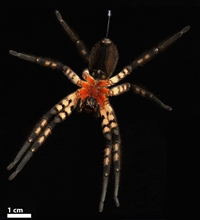Fibres in spider's fangs inspire ideas better, bio-inspired material design
12 May 2012
Among the factors that make spiders successful predators is the ingeniously composed and structured material of their fangs.
 |
| Predatory success based on a material advantage: Cupiennius salei, a tropical wandering spider, penetrates the armour of insects of prey with its venom fangs. The fangs are composed of chitin and proteins like the prey's cuticular armour, but their precise chemical composition and structure are particularly well-adapted to their function. © R Barth |
Although their armour consists of the same material as their predator's fangs, flies, grasshoppers and other insects that are the usual prey of spiders have little to offer by way of defence against the spider's bite. As researchers of the Max Planck Institute of Colloids and Interfaces in Potsdam, the Max Planck Institute of Microstructure Physics in Halle and the University of Vienna have discovered, the chitin fibres in the fangs of a large Central American wandering spider are arranged and surrounded with proteins in a way that makes the material particularly rigid and thus capable of penetrating its prey's cuticular armour.
Thanks to the composition and structure of their materials, the fangs become optimised and reusable hypodermic needles for injecting prey with paralysing venom. The new insights into this biological material could provide inspiration for the optimisation of similar technical materials and devices.
Nature has been using fibre-reinforced materials far longer than technology. The material of the armour deployed by arthropods, such as arachnids, insects and crustaceans, the cuticle, is composed of a multitude of extremely fine layers of chitin fibres.
The fibres arrange themselves parallel to the surface and are typically embedded in a protein matrix. This natural composite adapts to its wide-ranging uses through the strong variations in both the composition and form of the material in different parts of the exoskeleton.
The arrangement of the fibres and the protein composition have a crucial influence on the mechanical properties of the material.













.jpg)






.jpg)









